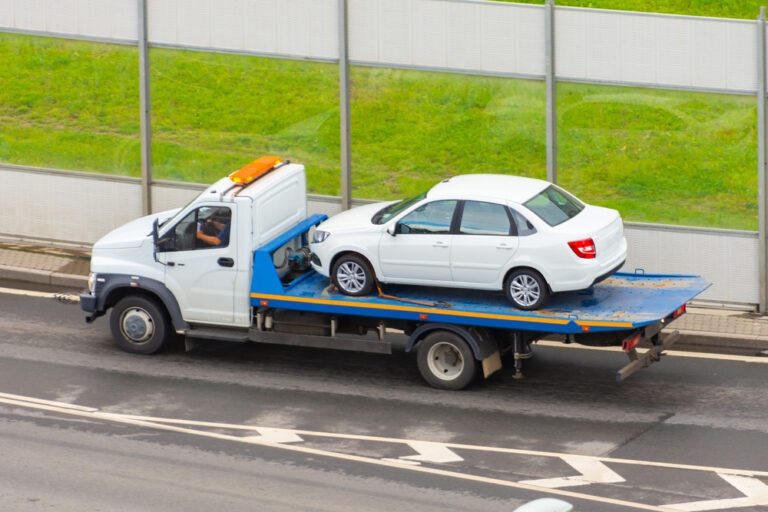
How Long Does it Take to Ship Car Cross Country?
t’s not e=mc2. But it’s a useful equation nonetheless:
Car-Shipment Timing = Road Trip + Delays + Multiple Deliveries.
That’s how long it takes to ship a car across the country.
The shipping starts with picking the thing up and securing it in a transport trailer with other vehicles making the trip.
Then the driver, well, drives—and, along the way, there are meal breaks and hotel stops, and sometimes poor weather, and sometimes dense traffic, and almost always delays of some sort.
Because most transport trailers carry more than one vehicle on long trips, your delivery window may also be affected by how long it takes to make the other deliveries.
An experienced car-transport service will give you an estimated window of several days in which to expect delivery, because long-distance transportation cannot be predicted down to the moment, or even the hour, or day. In fact, here’s some advice: be suspicious if anyone gives you too exact a window.
After all, long-distance road transport is, well—long-distance road transport.
The Time It Takes to Drive the Distance
Google “the inexact science of predicting” and you’ll turn up all manner of ways to end that sentence:
- “…the path of COVID-19.”
- “…a Major League Baseball draft.”
- “…influenza.”
- “tsunamis.”
- “…surf.”
- “…the weather.”
The inexact science of predicting the duration of a long road trip isn’t on the list, but it should be.
The first and most important element of car-transport timing is the road trip itself. And the certitude that on long road trips, time is often lost and not often gained.
Part of a trip’s timetable can be plotted out, especially meal and sleep breaks. Getting enough rest is important for the driver as well as nearby motorists. Studies have shown that someone who is awake too long—20 hours, say—can be as impaired as a person who is legally drunk, so planning for sleep breaks is part of the program. But some of the trip is about navigating surprises.
A 2013 study found that the proportion of a truck trip with no delays was about 75%, the part with expected delays was 19%, and the part with unexpected delays 6%. Delays associated with truck deliveries include congestion on major highways, accidents, and bad weather, according to the Transportation Association of Canada.
The More-or-Less Approach to Scheduling
Between unexpected delays and those that can more-or-less be planned for—rests, potty breaks, sleep time, and meals—drivers can cover a certain distance each days a road trip will usually require. For example, a trip from New York to Los Angeles takes five to six days, including five hotel stops.
Trip calculus also involves matters outside anyone’s control, such as road delays, which happen to everyone and can’t be avoided, no matter how experienced the driver or white-glove the service. Large tractor-trailers are also particularly susceptible to poor road conditions, from icy weather to rush-hour slowdowns.
A vehicle-transport service will typically pad its delivery estimate by up to three days to cover possible delays, including time a driver may spend pulled over waiting for weather or road conditions to clear.
Multiple-Delivery Timing
An open- or enclosed trailer can carry more than one vehicle.
For this reason, clients share a vehicle-delivery window, and the time it takes to reach other clients and destinations may affect when your vehicle arrives.
If you are flexible and available or have someone available to sign for you, this one-to-two-day difference should not affect your overall car-shipping experience.
Shipping companies that handle multiple pick-ups and drop-offs along the route can multiply the time it takes your vehicle to reach its destination. This creates a different kind of delivery window that will need to be handled with your shipping partner.
Premium Strict Pickup or Delivery Windows
Professionals relocating are the most likely to need their vehicles picked up on a specific day, or delivered by a specific date. Those clients can purchase a strict pickup or delivery window in which your vehicle’s handling is prioritized over other pickups or deliveries.
However, this arrangement is only able to purchase more efficient delivery and cannot account for things like baseline transport time and uncontrolled delays.
ShipLux drivers average about 500 miles per day and offer seven- to 10-day cross-country vehicle deliveries. Enclosed shipping is often a little faster, at five to seven days, with fewer vehicles per trailer.
We give you a custom, cross-country car-shipping estimate that takes into consideration the baseline road-trip time between pickup and drop-off locations and the appropriate margin for possible delays in road conditions or pick-up and drop-off logistics.
To get a clear estimate of your car transport timing and costs, contact ShipLux today.
Recent post

General Shipping Information
Debunking Common Vehicle Transport ...

Car Shipping